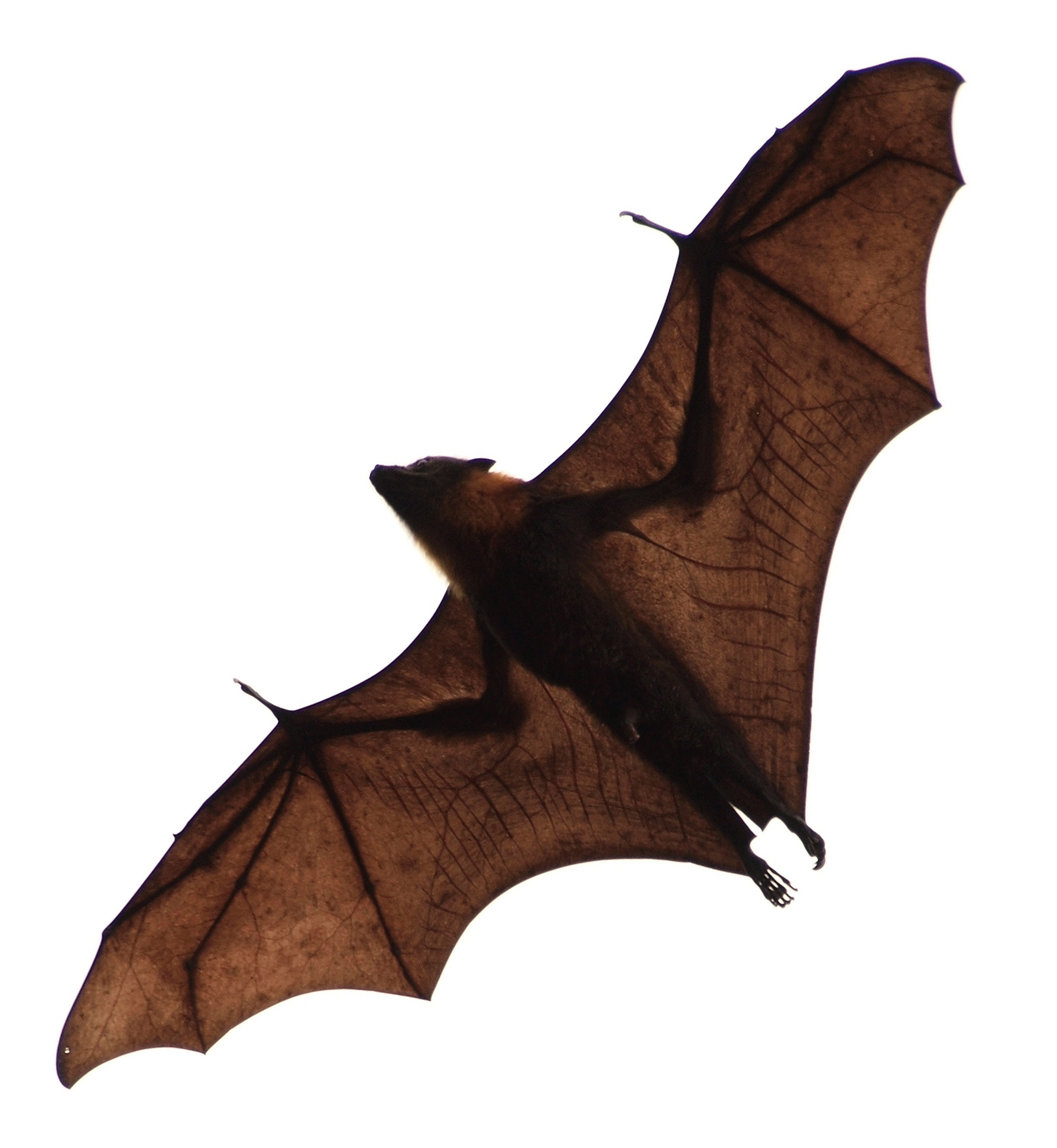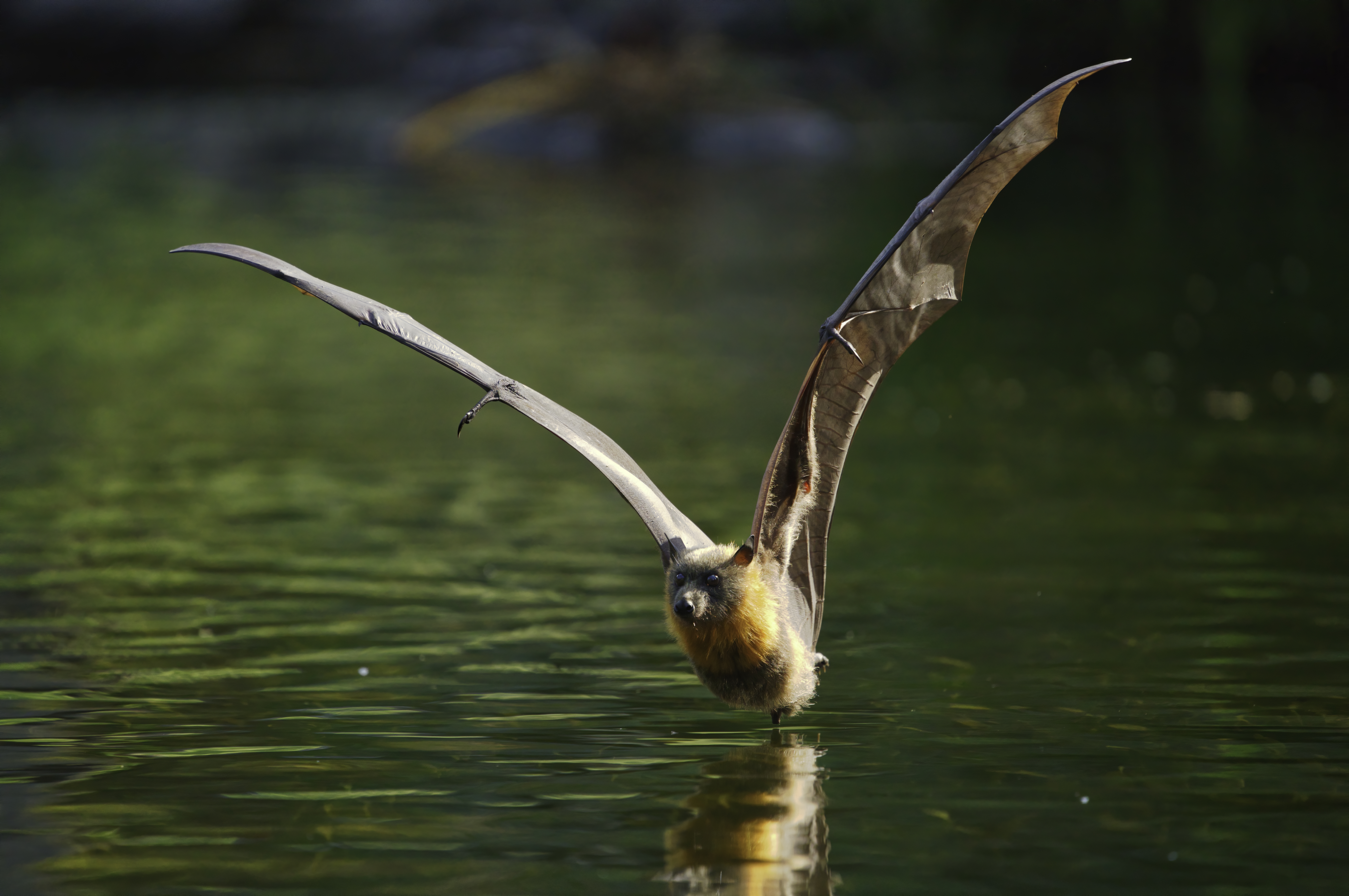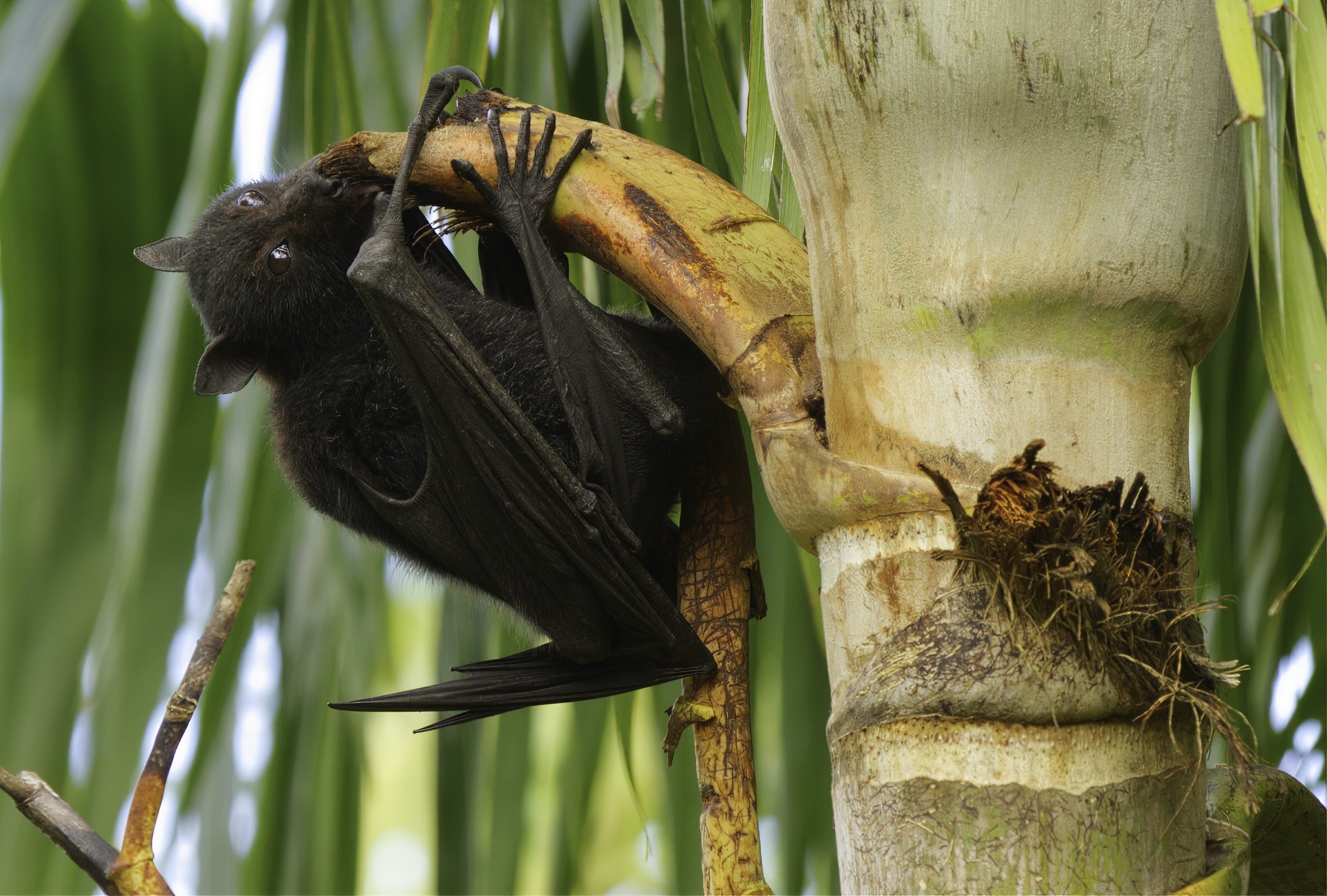|
Pteropodinae
The Pteropodinae are a subfamily of megabats. Taxa within this subfamily are: * Genus ''Acerodon'' **Sulawesi flying fox, ''A. celebensis'' **Talaud flying fox, ''A. humilis'' **Giant golden-crowned flying fox, ''A. jubatus'' **Palawan fruit bat, ''A. leucotis'' **Sunda flying fox, ''A. mackloti'' * Genus ''Desmalopex'' **White-winged flying fox, ''D. leucopterus'' **Small white-winged flying fox, ''D. microleucopterus'' * Genus ''Eidolon'' — straw-coloured fruit bats **Madagascan fruit bat, ''E. dupreanum'' **Straw-coloured fruit bat, ''E. helvum'' * Genus ''Mirimiri'' **Fijian monkey-faced bat, ''M. acrodonta'' * Genus ''Neopteryx'' ** Small-toothed fruit bat, ''N. frosti'' * Genus ''Pteralopex'' - flying monkeys **Bougainville monkey-faced bat, ''P. anceps'' **Guadalcanal monkey-faced bat, ''P. atrata'' **Greater monkey-faced bat, ''P. flanneryi'' **Montane monkey-faced bat, ''P. pulchra'' **New Georgian monkey-faced bat, ''P. taki'' *Genus ''Pteropus'' — flying foxes **''P ... [...More Info...] [...Related Items...] OR: [Wikipedia] [Google] [Baidu] |
Megabat
Megabats constitute the family Pteropodidae of the order Chiroptera (bats). They are also called fruit bats, Old World fruit bats, or—especially the genera ''Acerodon'' and ''Pteropus''—flying foxes. They are the only member of the superfamily Pteropodoidea, which is one of two superfamilies in the suborder Yinpterochiroptera. Internal divisions of Pteropodidae have varied since subfamilies were first proposed in 1917. From three subfamilies in the 1917 classification, six are now recognized, along with various tribes. As of 2018, 197 species of megabat had been described. The leading theory of the evolution of megabats has been determined primarily by genetic data, as the fossil record for this family is the most fragmented of all bats. They likely evolved in Australasia, with the common ancestor of all living pteropodids existing approximately 31 million years ago. Many of their lineages probably originated in Melanesia, then dispersed over time to mainland Asia, t ... [...More Info...] [...Related Items...] OR: [Wikipedia] [Google] [Baidu] |
Pteropus
''Pteropus'' (suborder Yinpterochiroptera) is a genus of megabats which are among the largest bats in the world. They are commonly known as fruit bats or flying foxes, among other colloquial names. They live in South Asia, Southeast Asia, Australia, East Africa, and some oceanic islands in the Indian and Pacific Oceans. There are at least 60 Extant taxon, extant species in the genus. Flying foxes eat fruit and other plant matter, and occasionally consume insects as well. They locate resources with their keen sense of smell. Most, but not all, are nocturnality, nocturnal. They navigate with keen eyesight, as they cannot Animal echolocation, echolocate. They have R/K selection theory#K-selection, long life spans and low reproductive outputs, with females of most species producing only one offspring per year. Their slow life history makes their populations vulnerable to threats such as Overexploitation, overhunting, culling, and natural disasters. Six flying fox species have been ... [...More Info...] [...Related Items...] OR: [Wikipedia] [Google] [Baidu] |
Pteropus Poliocephalus
The grey-headed flying fox (''Pteropus poliocephalus'') is a megabat native to Australia. The species shares mainland Australia with three other members of the genus Genus ( plural genera ) is a taxonomic rank used in the biological classification of extant taxon, living and fossil organisms as well as Virus classification#ICTV classification, viruses. In the hierarchy of biological classification, genus com ... ''Pteropus'': the little red ''Pteropus scapulatus, P. scapulatus'', spectacled ''Pteropus conspicillatus, P. conspicillatus'', and the black ''Pteropus alecto, P. alecto''. The grey-headed flying fox is the largest bat in Australia. The grey-headed flying fox is endemic to the south-eastern forested areas of Australia, principally east of the Great Dividing Range. Its range extends approximately from Bundaberg, Queensland, Bundaberg in Queensland to Geelong, Victoria, Geelong in Victoria (Australia), Victoria, with outlying colonies in Ingham, Queensland, Ingham and ... [...More Info...] [...Related Items...] OR: [Wikipedia] [Google] [Baidu] |
Small White-winged Flying Fox
The small white-winged flying fox (''Desmalopex microleucopterus'') is a species of megabat in the family Pteropodidae.''A new species of ''Desmalopex'' (Pteropodidae) from the Philippines, with a phylogenetic analysis of the Pteropodini'' by Jacob A. Esselstyn, Harvey J. D. Garcia, Mylanar G. Saulog, and Lawrence R. Heaney, 2008. It is known from Mindoro Island, in the Philippines The Philippines (; fil, Pilipinas, links=no), officially the Republic of the Philippines ( fil, Republika ng Pilipinas, links=no), * bik, Republika kan Filipinas * ceb, Republika sa Pilipinas * cbk, República de Filipinas * hil, Republ .... Only 13 specimens have ever been found; one in 1998 and the others in 2006. References Desmalopex Bats of Southeast Asia Mammals described in 2008 {{fruit-bat-stub ... [...More Info...] [...Related Items...] OR: [Wikipedia] [Google] [Baidu] |
Silvery Flying Fox
The silvery flying fox (''Pteropus argentatus''), also known as Ambon flying fox, or silvery fruit bat, is a megabat in the genus ''Pteropus'' from eastern Indonesia. It is known from a single, damaged, and immature specimen that was thought to have been from Ambon, but may in fact have been collected on Gebe Island. Although often included in ''Pteropus chrysoproctus The Moluccan flying fox (''Pteropus chrysoproctus''), also known as the Ambon flying fox, is a species of megabat in the genus ''Pteropus''. It is found in the low-lying forests (less than 250 m above sea level) of Seram Island (including Manusel ...'', it was reinstated as a separate species in 2008. References Pteropus Mammals of Indonesia Mammals described in 1844 Taxonomy articles created by Polbot Taxa named by John Edward Gray Bats of Indonesia Taxobox binomials not recognized by IUCN {{fruit-bat-stub ... [...More Info...] [...Related Items...] OR: [Wikipedia] [Google] [Baidu] |
Ashy-headed Flying Fox
The ashy-headed flying fox or North Moluccan flying fox (''Pteropus caniceps'') is a species of bat in the family Pteropodidae. It is endemic to Indonesia. Taxonomy and etymology It was described as a new species in 1870 by British zoologist John Edward Gray. The holotype had been collected on the Bacan Islands by Alfred Russel Wallace. Its species name "'' caniceps''" means "gray-headed" from Latin '' canus'' (gray) and '' -ceps'' (headed). This species has two subspecies: *''P. c. caniceps'' *''P. c. dobsoni'' (named for zoologist George Edward Dobson) Description Its forearm is long. Range and habitat This species is endemic to Indonesia. It has been found at elevations up to above sea level. Conservation As of 2016, it is assessed as a vulnerable species by the IUCN. It meets the criteria for this assessment because its population decline has been at least 30% from 1992–2016. Additionally, it is experiencing habitat fragmentation Habitat fragmentation describes ... [...More Info...] [...Related Items...] OR: [Wikipedia] [Google] [Baidu] |
Black Flying Fox
The black flying fox or black fruit bat (''Pteropus alecto'') is a bat in the family Pteropodidae. It is among the largest bats in the world, but is considerably smaller than the largest species in its genus, ''Pteropus''. The black flying fox is native to Australia, Papua New Guinea, and Indonesia. It is not a threatened species. Taxonomy Juvenile specimens of this species from Moa Island in Torres Strait have been described as a separate species, ''Pteropus banakrisi''. This supposed species was known as the "Torresian flying fox" or "Moa Island fruit bat". Description The black flying fox has short, black hair with a contrasting reddish-brown mantle, and a mean forearm length of 164 mm (6.46 in) and a mean weight of 710 g (1.57 lb). It is one of the largest bat species in the world, and has a wingspan of more than 1 m. Distribution Black flying foxes are native to Australia (New South Wales, Queensland, Northern Territory and Western Australia), Pa ... [...More Info...] [...Related Items...] OR: [Wikipedia] [Google] [Baidu] |
New Georgian Monkey-faced Bat
The New Georgian monkey-faced bat or New Georgian flying monkey (''Pteralopex taki'') is a recently described species of megabat endemic to the New Georgia and Vangunu Islands. It is presumably extinct on Kolombangara Island, and the remaining populations on other islands are threatened by habitat loss and hunting. Consequently, it is considered vulnerable by the IUCN. In 2013, Bat Conservation International Bat Conservation International (BCI) is an international nongovernmental organization working to conserve bats and their habitats through conservation, education, and research efforts. BCI was founded in 1982 by bat biologist Merlin Tuttle, who ... listed this species as one of the 35 species of its worldwide priority list of conservation. References Pteralopex Bats of Oceania Endemic fauna of the Solomon Islands Mammals of the Solomon Islands Endangered fauna of Oceania Mammals described in 2002 {{fruit-bat-stub ... [...More Info...] [...Related Items...] OR: [Wikipedia] [Google] [Baidu] |
Montane Monkey-faced Bat
The montane monkey-faced bat or montane flying monkey (''Pteralopex pulchra'') is a megabat endemic to the Solomon Islands. It is listed as a critically endangered species. Due to its imperilled status, it is identified by the Alliance for Zero Extinction as a species in danger of imminent extinction. In 2013, Bat Conservation International listed this species as one of the 35 species of its worldwide priority list of conservation. Only one individual has ever been found. Taxonomy and etymology It was described as a new species in 1991 by Australian mammalogist Tim Flannery. The holotype was collected in May 1990 on Mount Makarakomburu, which is on Guadalcanal Island. Its species name "''pulchra''" is . Description It is the smallest member of its genus. The holotype weighed . The length of its head and body together is . Its forearm is long. Its ears are short and narrow, at long. Like other monkey-faced bats, it wings attach to the body near the spine rather than at the s ... [...More Info...] [...Related Items...] OR: [Wikipedia] [Google] [Baidu] |
Greater Monkey-faced Bat
The greater monkey-faced bat or greater flying monkey (''Pteralopex flanneryi'') is a megabat endemic to Solomon Islands, Bougainville, in Papua New Guinea, and nearby small islands. It is listed as a critically endangered species and the population is decreasing. It is the largest monkey-faced bat. Taxonomy and etymology Prior to 2005, it was considered synonymous with the Bougainville monkey-faced bat. It was described as a new species in 2005 by Kristofer Helgen. Helgen chose the species name ''flanneryi'' to honor Dr. Tim Flannery, "in recognition of his studies of Melanesian mammals."Helgen, K. M. (2005). Systematics of the Pacific monkey-faced bats (Chiroptera: Pteropodidae), with a new species of Pteralopex and a new Fijian genus. Systematics and Biodiversity, 3(4), 433-453. As of 2017, no genetic analysis has been conducted on the members of the genus ''Pteralopex''; however, it is hypothesized that the closest relative of the greater monkey-faced bat is the Guadalcana ... [...More Info...] [...Related Items...] OR: [Wikipedia] [Google] [Baidu] |
Guadalcanal Monkey-faced Bat
The Guadalcanal monkey-faced bat or Guadalcanal flying monkey (''Pteralopex atrata'') is a megabat endemic to Solomon Islands. It is listed as an endangered species. In 2013, Bat Conservation International listed this species as one of the 35 species of its worldwide priority list of conservation. Taxonomy and etymology It was the first species of its genus, the monkey-faced bats, to be described. It was described by British zoologist Oldfield Thomas in 1888, based on a specimen that had been collected by British naturalist Charles Morris Woodford. Woodford collected the holotype in Aola Bay of Guadalcanal Island, which is a part of the Solomon Islands. While they were both initially described as distinct species, the Guadalcanal monkey-faced bat was considered synonymous with the Bougainville monkey-faced bat from 1954–1978. At present, they are again both considered full species. Its species name ''atrata'' is derived from the Latin word atratus, meaning "clothed in bla ... [...More Info...] [...Related Items...] OR: [Wikipedia] [Google] [Baidu] |
Bougainville Monkey-faced Bat
The Bougainville monkey-faced bat or Bougainville flying monkey (''Pteralopex anceps'') is a megabat endemic to Bougainville Island of Papua New Guinea and Choiseul Island of the Solomon Islands in Melanesia.Bowen-Jones, E., Abrutat, D., Markham, B., & Bowe, S. (1997). Flying foxes on Choiseul (Solomon Islands)–the need for conservation action. Oryx, 31(3), 209-217. It inhabits mature forests in upland areas, within the Autonomous Region of Bougainville and Bougouriba Province. Discovery and taxonomy It was first collected by English naturalist Albert Stewart Meek in April 1904 from Bougainville Island. That specimen was later used by Danish zoologist Knud Andersen in 1909 to describe a new species. The species name ''anceps'' comes from Latin, meaning "double-headed" or "having two heads." This could possibly be a reference to it being the second described member of ''Pteralopex'', or that it had characters similar to both ''Pteralopex'' and ''Pteropus'', especially the Bonin ... [...More Info...] [...Related Items...] OR: [Wikipedia] [Google] [Baidu] |



